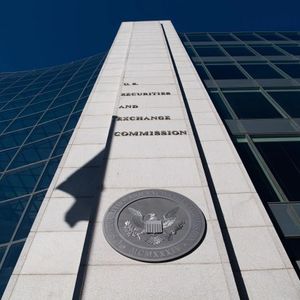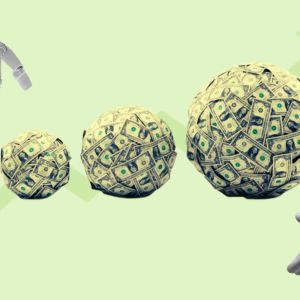

Bitcoin Forecast: Stormy Weather, Time To Sell
Summary Bitcoin's extreme volatility suggests it will fall faster and further than other equities in a recession, making now a good time to take profits. Historical trends show Bitcoin drops significantly during market sell-offs but eventually rebounds, indicating holding through downturns could be wise if profits can't be taken. Current market fundamentals, including potential Fed rate cuts and global economic instability, signal a looming recession, which could trigger a massive Bitcoin sell-off. Despite its volatility, Bitcoin's underlying blockchain technology ensures its long-term presence, making it a viable investment for future buying opportunities. Bitcoin USD (BTC-USD) is a legendary millionaire maker. However, this cyber currency's road to glory is pockmarked with steep stomach-churning downturns. Those hapless investors who sold their Bitcoin holdings at a loss can easily wind up with deep regrets once it springs back. This analysis is not a diatribe against Bitcoin, far from it. But like any other equity, there is a time to invest, and there is a time to take your winnings and stand by for another buying opportunity. Timing the markets is tricky, but a flurry of red flags is flapping around Bitcoin and the rest of the global marketplace. Now might be an excellent time to take profits on this wildly volatile cyber currency and sit on the sidelines for a while. If you cannot take a profit on Bitcoin, holding it through a steep downturn could likely be the next best option. Since it arrived in the financial marketplace in 2009, Bitcoin has been soaring and crashing . But the overall momentum is in a decidedly upward direction as you can see from the historical charts below. In a nutshell, the fundamentals indicate investors should either bank their Bitcoin profits for now or ride out the coming storm. Either way, Bitcoin will most likely do what it always does when it springs back from a crash- soar past its most recent high. How Bitcoin Performed Over Past Two Market Sell-offs During the Covid Crash from February to March 2020, the Nasdaq dropped 30% over 33 days. Meanwhile, Bitcoin dropped 52% over 27 days. It also got a head start on the Nasdaq by roughly one week as you can see from the charts below. When the Fed announced its plans for a series of rate hikes in December 2021 , the Nasdaq dropped 37% from its most recent high in November of that year, before reversing course one year later. Over that same period, Bitcoin lost 76% of its value. Fig. 1 Yahoo.com Unfortunately, we only have those two market corrections to go by. Bitcoin wasn't around during the Great Recession of 2007-09, let alone the 2000 Dotcom Recession. But when responding to market turbulence it has demonstrated a high level of volatility since its inception. How Bitcoin Compares To The Rest Of The Market Many experienced investors claim that Bitcoin follows the NASDAQ, which is arguably true. But if you look at the historic charts below, it appears Bitcoin rises and falls with the waves of the global marketplace, but it's much more volatile than other equities. While it's a matter of opinion, it appears that Bitcoin most closely tracks the Russell 2000 index, which makes sense since it is more volatile than the NASDAQ, which is more volatile than the S&P 500 and The Dow. Fig. 2 How Bitcoin historical chart compares to Russell 2000, NASDAQ, S&P 500 (Yahoo.com) Market Fundamentals A steep market drop in the first week of August may have been the catalyst that prompted Fed Chair Jay Powell to announce that "The time has come for policy to adjust", a broad hint that there will be a drop in the prime rate shortly. Market watchers are assuming at the next FOMC meeting on September 17-18, the Fed will announce a quarter-point drop in the prime rate, maybe even a half-point. Rate-cut proponents predict lower rates will forestall a market sell-off and keep this bull market galloping. Cryptocurrency bulls are pawing the ground waiting for loose money freed up by the Fed to come washing into Bitcoin like an oncoming tide. But such rosy expectations are based on how the Fed Put has performed in the past. They don't take into account current market fundamentals. The Yen Carry Trade The first big quake in the markets this year did not come from Wall Street, or even Washington D.C. Rather it came from an unexpected quarter, our friend and long-standing ally, Japan. After three decades of a near-zero prime rate , the Bank of Japan raised the rate to 0.25%. What seemed like an insignificant increase set off a stampede for the exit of the yen/dollar carry trade. Over the first week of August, the S&P 500 dropped over 7%. Fig. 3 Yahoo.com The yen carry trade is a popular investment strategy wherein international investors borrow a large amount of yen at low interest rates and buy higher-yielding assets denominated in another currency, in this case, US stocks and bonds. In response to the market turmoil set off by the BOJ's quarter-point rate increase, the BOJ's Deputy Governor Shinishi Uchida announced that the central bank won't initiate further rate increases while the markets are unstable. Nonetheless, Japan is facing serious economic problems of its own. Primarily, the Japanese birthrate has plunged so far below replacement level that it has become an existential threat as the country's burgeoning population of elderly retired citizens are relying increasingly on an ever-dwindling population of workers for financial support. The big question was why. When Japanese officials looked into the matter what they discovered was jarring. Japanese working-class wages had dropped so low in comparison to the prior generation, adults in their 20s, 30s, and 40s claimed they weren't having children because they simply could not afford to, and they had no desire to force their prospective children to struggle in poverty. Last February Japan's chief cabinet secretary, Yoshimasa Hayashi , declared the condition critical and said that Japan had six years to restore the working class to its former prosperity to avoid an outright crisis. This indicates Japan's determination to reverse course on its longstanding zero-rate policy in order to raise wages. Financial officials, there are now embracing "good inflation", another indication they're willing to stay the course and endure whatever inconvenience comes with it. It all boils down to this. Japan has assured the US they will be as light-handed as humanly possible as they gradually raise rates. But like any other government, their priority is their nation's future. Japan must strengthen the yen and raise wages to give their working-class enough prosperity to afford a family. For Japan, this is not a nice-to-have, it is an absolute must-have. And as their chief cabinet secretary has recently announced, they want to see dramatic results in six years. The Unintended Consequences of Rate Cuts While rate cuts have become a market shibboleth, promising a one-size-fits-all cure for every recession, they may have become a way to forestall an inevitable round of belt-tightening, both on Wall Street and in our government. Loose money policies offer little more than a bigger credit line. When governments overuse this dubious solution, numerous risk factors can accumulate. A rate cut reduces incentive to buy long-term bonds When bond rates go lower, the price goes higher since the two are inversely related. That means that as rates come down, the incentive to buy US Treasuries goes down along with it. Meanwhile, the government is determined to sell a record amount of bonds to pay for a record-breaking budget, including interest on a record-breaking debt. This predicament is just one of several Catch-22s woven into the bond math. Foreign buyers of US Treasuries have been declining over the past decade or so. Raising rates would likely send even more foreign buyers running for the exits. Fig. 4 Share of U.S. Treasury Securities (Created by CRS. Data from Board of Governors of the Federal Reserve) Fig. 5 Foreign Direct Investment (U.S. Bureau of Economic Analysis) Inflation One likely outcome of a rate cut is higher inflation which could trigger a forceful backlash from the middle class, still furious about the high rate of inflation that took the economy by surprise at the end of the COVID-19 pandemic. The fact we are now in the dead heat of a presidential election year means this issue could bring a great deal of pressure on the Fed to reverse course, both from the electorate and the current administration. Bear in mind that most financial experts agree that Wall Street traders have already priced several rate cuts into these current stock price valuations. If the Fed does cut rates, and then does a quick about-face, this could spell disaster for the stock market. Traders would likely reverse their expectations of another bull run and price in their expectations for rising rates instead. Such expectations might trigger a sell-off. A Rate Cut Could Spur Profit-taking Among Bondholders The reason the 10-year Treasury rates have been trailing behind the 2-year Treasury (until very recently) is because the former has been in much higher demand than the 2-year. If bond traders are assuming that there are a series of rate cuts in our future, it would make sense for them to load up on 10-year bonds, and then sell them into the secondary market at a profit once the rates drop. As the Fed lowers rates, the incentive to buy the 10-year to take advantage of the higher rate dries up. Meanwhile, the incentive to sell at a profit increases. So even as demand wanes, the supply is likely to increase, driving down the price of bonds. If this scenario plays out the interest rates on bonds would likely trend up at the government auctions. Lowering rates in this scenario could turn into a negative feedback loop as the very act makes bonds less attractive. The Yen Carry Trade Redux Since investors driving the yen/dollar carry trade are taking advantage of the differential between the BOJ's historically low prime rate and the Fed's considerably higher prime rate, any financial move that closes that gap could set off another rush for the exits of this financial gambit as we saw in the first week of August. This could cause more downward pressure on stock prices. Rate Cuts Could Invite US Bond Rating Downgrade Another risk of lowering interest rates is that it could invite a credit rating downgrade to US Treasuries. In August of last year, Fitch Ratings downgraded the U.S. long-term credit rating from AAA to AA+. It doesn't sound like much, but this was only the second time in history that a prestigious credit rating agency downgraded US bonds. The reasons given were as follows. The US's soaring national debt. The lack of a plan to address solutions for the debt. The deterioration of good governance. Later that year in November, Moody's Investor Services reduced its outlook on US credit ratings from "stable" to "negative". While the credit rating agency kept the US's top credit rating at AAA, rather than downgrading it, the announcement was likely intended as a warning shot across the US government's bow. The Yield Curve Reversion Perhaps the most reliable recession indicator is the yield curve reversion. Most experienced investors are aware that yield curve inversions nearly always precede a recession. The only question is by how long? The yield curve inversion of the 10-year Treasury and the 2-year Treasury recently set a record for the length of time it has been inverted-for over two years according to the St. Louis Fed's yield curve inversion charts. The 10-year Treasury and the 2-year Treasury inverted in July 2022. This yield curve has recently crept above the zero line like a thief in the night-first on August 28, more recently on September 4th. Notice that recessions, represented by the vertical gray bars, come either shortly or immediately after the yield curve comes back above the zero line. Fig. 6 10-Year Treasury Minus 2-Year Treasury (Federal Reserve Bank of St. Louis) Yield Curve Reversions Can Signal Two-Year Outlook For A Market Bottom Let's take a close look at the mechanics of the Treasury yield reversion process to see what's going on. The 10-year Treasury typically pays a higher interest rate than the 2-year Treasury because of the greater risk involved in holding a security for a long period of time. But sometimes market forces push the 10-year yield below the 2-year yield in what's known as a yield-curve-inversion. The dynamics behind this trend are generally institutional bond investors buying up 10-year notes with the expectation that rates will drop in response to a future recession. Since the Fed generally lowers rates after a recessionary stock market drop, the bond traders are confident they can sell their high-yield 10-year notes at a profit before their term. So, now the question is, what market mechanics are suddenly making the 2-year notes more popular than the 10-year notes? Mapping the dates of the 10-year/2-year reversions on an S&P 500 historical chart is revealing. Fig. 7 S&P 500 Chart 1990-2010 (Yahoo.com) As you can see from the chart above, there is roughly a 2-year interval between when the rate of the 2-year Treasury dips back below the rate of the 10-year, and the S&P 500 reaches a market bottom after a steep downturn. Could this be the bond traders' collective self-fulfilling prophecy? Or do the most successful bond traders have a witching-rod instinct for knowing when a steep market correction is near? If the latter is the case, then it appears bond traders are switching from Phase I, loading up on the 10-year bond in anticipation of recession on the horizon, to Phase II, shifting to the 2-year Treasury in anticipation of a near-term recession, followed by excellent buying opportunities in two years. Whichever it is, there seems to be a correlation between the reversion of the yield curve and a bottoming of the stock market roughly 2 years later. It will be interesting to see if this pattern holds in the coming 2 years. Why Squeezed Investors Are Likely To Sell Bitcoin First In a recessionary environment, experienced investors are likely to exit Bitcoin first specifically because it is so extremely volatile. Any signals the markets are weakening could trigger a massive Bitcoin sell-off. After reaching over $73,800 in mid-March this year, Bitcoin has been easing off its most recent high. While Bitcoin could get an initial sugar rush from a Fed rate drop, the overall market fundamentals will likely catch up and make it short-lived. Fig. 8 Yahoo.com Caveat Most market watchers believe that Fed rate cuts will spur equities across the board, and Bitcoin stands to be a big beneficiary. If they're proven right, anyone who sells Bitcoin now could miss out on that second bull market. A Final Word About Bitcoin Cyber currency detractors believe the value of Bitcoin is completely illusionary because it is intangible. But the blockchain technology upon which Bitcoin is based is here to stay. Cyber currency tracked on a public blockchain ledger is here to stay. That genie will not be stuffed back in the bottle any time soon. So, it stands to reason if Bitcoin is the most popular cyber currency, it too is here to stay. Its value will likely continue to rise and fall in dramatic fashion but any prediction that Bitcoin will soon disappear from the world stage is a prediction that cyber currency will disappear, and that argument doesn't make sense. Summary Numerous forward indicators are signaling a recession on the near horizon. While Bitcoin has a short history, it has already demonstrated a pattern of following the ebbs and flows of the market, but in a much more volatile fashion than the rest of the equities and market indexes. If the global economy succumbs to a recession, Bitcoin will likely fall faster and further than the rest of the market, as it has already demonstrated. Now is a good time to take profits from Bitcoin and wait for buying opportunities in the future.














